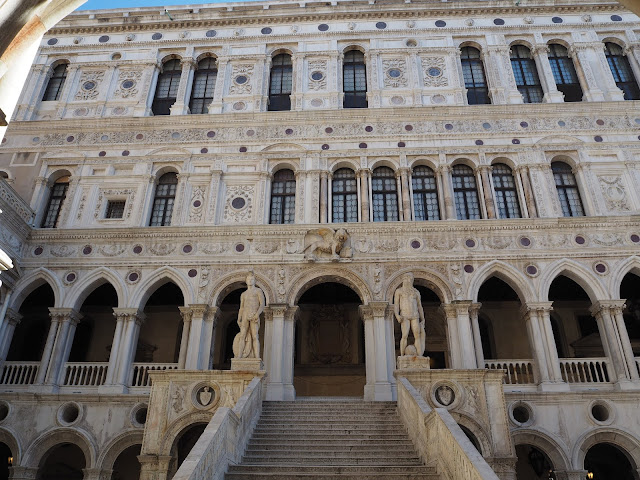【ヴェネツィア】ヴェネツィア共和国の中枢 ドゥカーレ宮殿① Venezia - The center of the Republic of Venice, Palazzo Ducale Part-1
サン・マルコ寺院のすぐ隣にある、ドゥカーレ宮殿。
海に面していて、アドリア海からヴェネツィアを訪れる際は、その正面玄関とも言える位置にあり、まさにヴェネツィアを象徴する建物だ。
ヴェネツィアの国家元首と言える総督の居城であり、議会、行政、裁判などもこの場所で行われ、裁判で有罪となった犯罪者を収容する牢獄もある。
9世紀に最初の建物がここに作られたが、現在の建物は14世紀から15世紀にかけて作られたもので、ヴェネツィアのゴシック建築を代表する建物になっている。
Palazzo Ducale, right next to St. Mark's Basilica.
Facing the sea, when visiting Venice from the Adriatic Sea, it is located at the front entrance, and it is a building that truly symbolizes Venice.
It is the residence of the governor-general, who can be said to be the head of state of Venice, where parliament, administration, and trials are held, and there is also a prison that holds criminals convicted in the trial.
The first building was built here in the 9th century, but the current building was built between the 14th and 15th centuries and is a representative of Gothic architecture in Venice.
サン・マルコ寺院の前には多くの人が入場待ちの行列を作っていたが、こちらは内部が広いこともあって、行列はほとんどなく、すんなりと内部に入ることができた。
チケットを買って中に入ると、最初に大きな中庭に出る。1500年代に作られたというブロンズ製の井戸があり、向こうにはサン・マルコ寺院の特徴あるドームが見える。
Many people were waiting in line in front of St. Mark's Basilica, but due to the large interior, there were few lines and I was able to enter the interior smoothly.
When you buy a ticket and go inside, you first go to the large courtyard. There is a bronze well that was built in the 1500s, and beyond that you can see the characteristic dome of St. Mark's Basilica.
ドゥカーレ宮殿とサン・マルコ寺院の間には、ポルタ・デラ・カルタ、布告門という素晴らしい装飾が施された門がある。
彫刻家バルトロメオ・ボンによって、1438年から1441年に作られたもので、15世紀のヴェネツィアの彫刻を代表する素晴らしい彫刻だ。
ヴェネツィアの象徴である獅子に向かって跪いているのは、この門が作られた時に総督を務めていたフランチェスコ・フォスカリ。
この時代は、ヴェネツィア共和国の絶頂期にあたる時代だった。1453年のオスマン帝国によるコンスタンチノープルの征服によって東ローマ帝国は崩壊した。
地中海の商業を実質的に支配していたヴェネツィア共和国だったが、この後は、徐々にオスマン帝国の勢力が地中海に広がっていく。
総督のフォスカリは、息子が贈収賄や汚職の罪でヴェネツィアを追放になり、その責任を問われる形で、1457年に十人委員会によって辞職させられてしまった。
ヴェネツィア共和国の国家元首である総督でも、十人委員会の決定には逆らえなかった。ヴェネツィア共和国の政治体制の特徴がよく表れている。
ヴェルディのオペラ『二人のフォスカリ』は、この事件を元に作られたオペラだ。
Between the Doge's Palace and St. Mark's Basilica, there is a wonderfully decorated gate called Porta della Carta, the Proclamation Gate.
Created by the sculptor Bartolomeo Bon from 1438 to 1441, it is a magnificent sculpture representing the 15th century Venetian sculpture.
Kneeling towards the lion, the symbol of Venice, is Francesco Foscari, who was governor when the gate was created.
This era was the heyday of the Republic of Venice. The Byzantine Empire collapsed in 1453 when the Ottoman Empire conquered Constantinople.
The Republic of Venice had virtually dominated the commerce of the Mediterranean, but after that, the power of the Ottoman Empire gradually spread to the Mediterranean.
Governor-general Foscari was resigned by the Council of Ten in 1457 after his son was banished from Venice for bribery and corruption and was held liable.
Even the governor-general, the head of state of the Republic of Venice, did not go against the decision of the Council of Ten. The characteristics of the political system of the Republic of Venice are well represented.
Verdi's opera "I Due Foscari" is an opera based on this incident.
海側の外に面した柱の上には、素晴らしい彫刻が所々に施されている。
これは旧約聖書の有名なエピソード、ソロモンの審判を表現したルネサンス時代の彫刻。
子供に刃を向けようとする人物にすがりつく母親の姿が見事に表現されているように見えるが、ジョン・ラスキンは『ヴェネツィアの石』の中で、この彫刻はゴシック時代の彫刻に比べると劣っている、と厳しい評価を下している。
There are some wonderful sculptures on the pillars facing the outside of the sea.
This is a Renaissance sculpture depicting the famous episode of the Old Testament, the Judgment of Solomon.
John Ruskin's sculpture in The Stone of Venice is inferior to the Gothic sculpture, although it seems to be a perfect representation of a mother clinging to a person trying to point her blade at a child. It is harshly evaluated.
ドゥカーレ宮殿は、14世紀から15世紀にかけて作られたが、その後もたびたび火災などに見舞われてその一部が改築されてきた。
巨人の階段と言われるこの階段は、1484年から1501年にかけてアントニオ・リッツォによってルネサンス様式で再建された。
1567年には階段の上に2体の巨人像が置かれて、それ以来、巨人の階段と呼ばれている。
かつてのここにあった階段は、14世紀に総督だったマリーノ・ファリエーロが、自らが世襲の君主となることを目論んで反乱を企てて失敗し、処刑された場所であると言われている。
Palazzo Ducale was built between the 14th and 15th centuries, but has been partially rebuilt afterwards due to frequent fires.
Known as the Giants' staircase, it was rebuilt in Renaissance style by Antonio Rizzo from 1484 to 1501.
In 1567, two giant statues were placed on the stairs, and since then they have been called the Giants' stairs.
The staircase that used to be here is said to be the place where Marino Fariero, the governor-general of the 14th century, was executed after failing in a rebellion attempting to become a hereditary monarch. ..
ドゥカーレ宮殿の中には牢獄があるが、あまりに犯罪者が増加して収容できなくなり、16世紀半ばに新たな牢獄が隣に建設された。その間を結んでいるのが、溜息の橋だ。
窓のない牢獄に連れて行かれる人物が、最後にこの橋の窓から外を眺めることができたという。
現在、牢獄の中は見学できる。その途中で、この橋の中を通るが、内部はいたって簡素な作りで、外部の豪華さとは大違いだ。
この橋は、海側の道を歩く人々がよく撮影するスポットになっている。
橋の中から海の方を眺めると、多くの人がこちらを見ていて、カメラを構えていたが、何とも複雑な感情に襲われた。
There is a prison in the Doge's Palace, but the number of criminals has increased so much that it cannot be accommodated, and a new prison was built next to it in the middle of the 16th century. The bridge of sighs connects them.
The person who was taken to the windowless prison was finally able to look out from the window of this bridge.
Currently, you can tour the prison. On the way, you will pass through this bridge, but the interior is very simple and it is very different from the luxury of the outside.
This bridge is a popular spot for people walking on the seaside road.
When I looked at the sea from the bridge, many people were looking at me and holding my camera, but I was struck by mixed emotions.
(Translated by Google Translate)








コメント
コメントを投稿